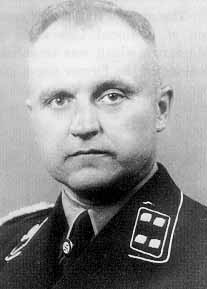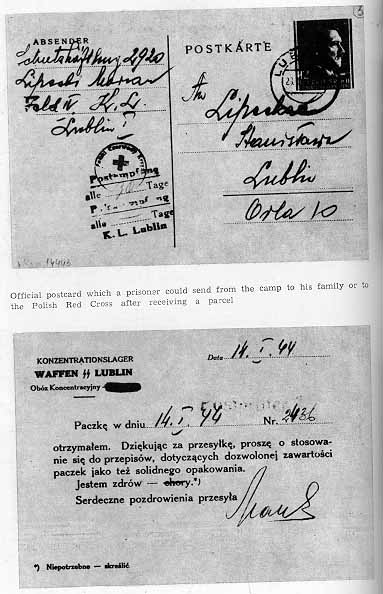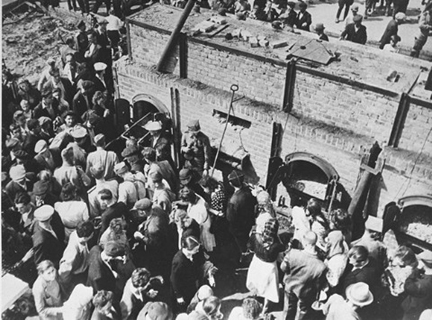Majdanek Concentration Camp The Majdanek concentration camp in the Polish city of Lubin was in operation from October 1, 1941 to July 23, 1944 when it was liberated by soldiers of the Soviet Union. The old photograph above shows the original main entrance into the concentration camp at Majdanek. On either side of the gate, there were sentry boxes, painted with black and white chevron stripes. One of these sentry boxes is currently on display in one of the barracks buildings which has been converted into a Museum. Although there doesn't seem to be much security at this gate, the interior of the camp was divided into fields or compounds, each surrounded by a double row of barbed wire fencing. According to the museum guidebook, the camp was initially called the Concentration Camp at Lublin (Konzentrationslager Lublin); then the name was changed to Prisoner of War Camp at Lublin (Kriegsgefangenenlager der Waffen-SS Lublin), but in Feb. 1943, the name reverted back to Concentration Camp. Throughout its existence, Majdanek received transports of Prisoners of War, including a few Americans. Although the first prisoners at Majdanek were Russian Prisoners of War, who were transferred from a barbed wire enclosure at Chelm, the camp soon became a detention center for Jews after the "Final Solution of the Jewish Question" was planned at the Wannsee Conference on January 20, 1942. Mass transports of Jews began arriving at the Majdanek camp, beginning in April 1942, during the same time period that the Auschwitz II camp, which was originally a POW camp for Soviet soldiers, was being converted to an extermination camp for Jews. The headquarters for Operation Reinhard, which was set up after the Wannsee Conference, was in Lublin, near the Majdanek camp. The clothing that was confiscated from the prisoners who were sent to the three Operation Reinard camps (Treblinka, Sobibor, and Belzec) was brought to Majdanek to be disinfected with a poison gas called Zyklon-B. The same gas was used in homicidal gas chambers at Majdanek to murder thousands of Jews. In sharp contrast to the extermination camp at Treblinka, which is in a wooded area as remote as Ted Kaczynkski's Montana cabin, the Majdanek concentration camp is situated in a major urban area, four kilometers from the city center of Lublin, and can be easily reached by trolley car. The location of the Majdanek camp is in an area of rolling terrain and can be seen from all sides; it could not be more public or accessible. The Majdanek concentration camp is located in an entirely open area with no ten-foot wall around it to hide the activities inside the camp, as at Dachau. There was no security zone established around the Majdanek camp, as at Birkenau, and there is no natural protection, such as a river or a forest, as at Treblinka. Besides being bounded on the north by a busy main road, the camp was bounded on the south by two small villages named Abramowic and Dziesiata. People driving past the camp, while it was in operation, had a completely unobstructed view, being able to see the tall brick chimney of the crematorium wafting smoke from the top of a slope not far away, and the gas chamber building which is a few yards from a busy street. Majdakek is also known as Maidenek, which is the German version of the name. Just as at the Auschwitz main camp, the first Jewish prisoners that were sent to Majdanek were 10,000 young men from Slovakia, followed by transports from the area that is now the Czech Republic. Jews from Austria, Germany, France and Holland were also sent to Majdanek, but from mid 1942 until mid 1943, most of the Jews sent to the camp were from the Lublin region and the ghettos of Warsaw and Bialystok. According to a Museum booklet, "The transports of Jews from the General Government were in direct connection with Action Reinhard whose aim was mass extermination of Jews and plunder of Jewish property. The headquarters of this action, managed by O. Globocnik, was in Lublin." The Action Reinhard camps were at Sobibor, Belzec and Treblinka, all on the border of Soviet-occupied Poland and the General Government, which was the name given to central Poland by the Nazis. Lublin is the easternmost large city in Poland. The population of Lublin has tripled since the end of World War II to its present total of 350,000, and the former Majdanek concentration camp is now within the city limits, like a municipal park except that it is a ghastly eyesore. There are several modern high-rise apartment buildings overlooking the camp on two sides now, and on one side, right next to the camp, is a Roman Catholic cemetery which was there even when the camp was in operation. On the other side of the street, directly across from the former concentration camp, there is now a Polish military installation since this street is part of the main road into the Ukraine and Russia. During World War II, the street which borders the Majdanek concentration camp was the main route to the eastern front for the German army. Lublin is near the eastern border of Poland and what is now the Ukraine. Between 1772 and 1918, when Poland had ceased to be an independent country and was divided between Prussia (Germany), Austria and Russia, Lublin was in the Russian sector. In April 1835, Russian Czar Nicholas I issued a decree which created the Pale of Settlement, a territory where Russian Jews were forced to live until after the Communist Revolution of 1917. Lublin was located within the Pale of Settlement, as was the city of Warsaw. The census of 1897 counted 4,899,300 Jews who were crowded into the Pale of Settlement, which was like a huge reservation similar to those where the Native Americans were forced to live during the same time period in the western USA. In 1881, Russia began evicting the Jews from the Pale, which began a mass migration. By 1914, two million Jews had left the Pale and had settled in Germany, Austria, America and other countries. In 1939, when Poland was again divided between Germany and the Soviet Union, Lublin came under the control of Russia again. This lasted until June 1941 when the Nazis launched an attack on the Communist Soviet Union, the ideological enemy of Fascist Germany. Lublin, being close to the border of the German-controlled General Government of Poland, was one of the first cities to be conquered by the Germans. The German conquest of the Soviet sector of Poland in the last 6 months of 1941 brought Polish Communists and also millions of Jews, who were the sworn enemies of the Nazis, under the control of the Germans. In order to avoid having partisans attack them from the rear as they advanced into Russia, the Nazis rounded up those whom they considered their political enemies and confined them in the Majdanek camp, along with the captured Soviet POWs.  During the Nazi occupation of Poland, there was no railroad spur line to bring the new prisoners directly into the Majdanek camp; the victims disembarked from cattle cars at the crowded main railroad station in Lublin amid German troops, also riding in cattle cars, on their way to the Eastern front. Even some regular passengers in Europe rode on freight trains during World War II, according to the author of Schindler's List. The prisoners destined for Majdanek were transported the rest of the way to the camp in trucks. At the Majdanek camp, there is a large field of grass near the street, in the middle of which stands a lone white stucco house, the former dwelling of the Camp Commandant. There were 5 different camp commanders during the 35 months that Majdanek was in operation: Karl Otto Koch, Max August Koegel, Hermann Florstedt, Martin Gottfried Weiss and Arthur Liebehenschel. Pictured below is Karl Otto Koch, the first Commandant of the Majdanek camp. Koch had previously been the Commandant of Buchenwald, but he was sent to Majdanek as punishment after he was arrested in Weimar for non-payment of taxes. In 1943, he was brought back to Weimar and put on trial by SS Judge Georg Konrad Morgen on charges of ordering the murder of two prisoners at Buchenwald and taking bribes from Jewish prisoners. He was convicted and executed by the Nazis before the end of the war.  Commandant Hermann Florstedt was also executed by the Nazis after he was convicted in Judge Georg Konrad Morgen's court on charges of stealing from the camp warehouses. There were 200 cases of cruelty and corruption in the concentration camps which were tried by Dr. Georg Konrad Morgen, the legal investigator of the Reich Criminal Police. Dr. Morgen testified at the Nuremberg IMT that he had examined 800 documents which resulted in 200 indictments of SS men who were staff members of the camps including Amon Goeth, the commandant at Plaszow, the camp which became famous as a result of the film, "Schindler's List." Goeth was awaiting trial in Dr. Morgen's court when the war ended. Goeth was tried by the People's Court at Krakow after the war; he was convicted and hanged. Two of the commandants of the Majdanek camp were tried by the Allies after the war. Max Koegel was sentenced to death by a British Military Tribunal in 1946. Martin Gottfried Weiss was tried before an American Military Tribunal at Dachau in November 1945 and received a death sentence for war crimes committed while he was the Commandant at the Dachau concentration camp. Arthur Liebehenschel, the last commandant of the camp, was sent to Majdanek in 1944 after serving as the commandant of Auschwitz for several months. When Majdanek was evacuated in July 1944, he was sent to Triest. He was convicted by the Supreme People's Court at Krakow in Poland and executed after the war. Among the inmates, according to the Museum guidebook, were a few American Prisoners of War. There was no mention of what happened to them in any of the Museum booklets, but according to Tollefson's book, "Enemy Prisoners of War," the American Red Cross reported after the war that "over 99% of our American prisoners captured by Germany are now returning home." The Germans honored the rules of the Geneva convention for American POWs and allowed inspections by the Red Cross, which were mandated for Prisoners of War. All the prisoners at Majdanek were allowed to receive Red Cross packages, as well as packages from Polish civilians who organized to provide aid. Below is a page from the Museum guidebook which shows the official Thank You postcard provided by the Nazis for the prisoners to send in acknowledgment of the receipt of a package.  "Official postcard which a prisoner could send from the camp to his family or to the Polish Red Cross after receiving a parcel." The Soviet Union had not signed the most recent version of the rules of the Geneva convention in 1929 and were not treating captured German soldiers in accordance with the convention, so the Germans felt justified in not following any war-time regulations with regard to their Soviet POWs. Polish soldiers, who were Jewish, were not treated in accordance with the Geneva convention, according to the Museum guidebook. They were at first put into a separate camp on Lipowa Street in Lublin, but beginning in 1942, many of them were transferred to the Majdanek camp as ordinary prisoners and not given POW status. According to my tour guide, the Soviet Union had already decided that after the war, Poland would be a Communist country, in keeping with the political ideology of the liberators. Consequently, Lublin was immediately set up as the capital of the new Polish government, which was to follow the Communist dictates of the Soviet Union. Anti-Communist Polish citizens were dispatched to Siberia from Lublin after the war. The decision to make the Majdanek camp into a Museum was made in August 1944, a month after the liberation of the camp. According to a Museum booklet, the Majdanek Museum was set up in November 1944 and became the first such museum at a former concentration camp, long before any of the other Nazi camps were even liberated. During the Communist regime, which lasted until 1989, all Polish citizens were encouraged to go on government-sponsored group tours to the former Nazi concentration camps as part of their indoctrination in hatred of the opponents of Communism. According to the tour guide, Polish schools taught a censored version of history during the Communist rule, leaving out such details as the Soviet invasion of Poland in 1920, but emphasizing the crimes of the Nazi Fascists. The photograph below shows the ovens where bodies were cremated in the Majdanek camp. On the day that the Soviet troops arrived in Lublin, the Nazis set fire to the wooden crematorium building that housed the cremation ovens. According to the Museum, this was done to cover up their crime of executing the prisoners from the Gestapo prison in Lublin on the day of the battle for Lublin. The prisoners were brought to the camp and shot in front of the ovens. Their burned corpses were found by the Soviet liberators. In the photo, Polish civilians are shown on a tour of the former camp.  The first-ever Allied war crimes trial took place in the Polish Special Penal Court in Lublin, starting on November 27, 1944, even before the end of World War II. Six men who had been captured during the liberation of the Majdanek camp were convicted and sentenced to death. Two of the men on trial were Heinz Stalp and Edmund Pohlmann, both of whom were Kapos, or German prisoners who were in charge of other prisoners in the camp. Theodor Schöllen and Hermann Vogel were guards in the camp. The other two defendants were administrative personnel at Majdanek: Anton Thernes was the deputy commandant of the camp and his aide was Wilhelm Gerstenmeier. The photograph below shows SS-Obersturmbannfuehrer Anton Thernes, standing on the left, during his trial in front of the Polish court.  Edmund Pohlmann, one of the accused Kapos, committed suicide during the trial. The other five were found guilty on December 2, 1944 and were executed the next day near the ruins of the crematorium at Majdanek. After the liberation of Lublin, Majdanek was taken over by the Soviet Army with fields IV and V being used as quarters for Soviet soldiers, while fields I and II were used by the 2nd Polish Army, which was formed after the liberation. German POWs were put into field VI before being sent to slave labor camps deep inside the Soviet Union; a few of them returned after a period of captivity lasting as long as 10 years. TourGas ChamberCrematoriumLiberationDeath StatisticsBack to Majdanek indexHomeThis page was last updated on July 21, 2009 |